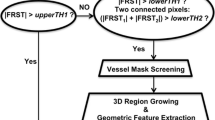Summary
With respect to the methodology of the atraumatic Xenon-133 technique the problem whether or not the proposed and introduced arterial artifact (AA) truely represents radiation from intravascular volume and to what extent it affects regional cerebral blood flow (rCBF) calculation is unresolved.
We performed rCBF measurements in 22 patients with angiomas to clarify this issue in those patients known to have pathologically enlarged intracranial vessels. P 4 — the parameter suggested to represent the AA — as well as the conventional blood flow parameter for gray matter (F 1) were compared to those of 50 volunteers using four criteria of abnormality: 1. intrahemispheric distribution, 2. interhemispheric differences of homologous detector pairs, 3. differences of mean hemispheric values, 4. visual evaluation of CBF maps.
19 of the 22 patients with angioma fulfilled at least two of the four criteria of abnormality, in comparison to 1 of 50 volunteers. P4's sensitivity for detecting angiomas proved to be higher (86%) than the perfusion parameters of gray matter. Focal increase of P 4 proved to be highly specific for the presence of arteriovenous malformation (AVM, specifity 98%). A true arterial artifact exists in most instances in the presence of an AVM. Disregarding AA in the algorithm for calculation rCBF leads to an artificial overestimation of tissue flow in the region of the AVM.
Similar content being viewed by others
Abbreviations
- rCBF:
-
regional cerebral blood flow
- AA:
-
arterial artifact
- AVM:
-
arteriovenous malformation
References
Brawanski A, Prohovnik I, Maximilian VA (1987) The clinical application of a new CBF index in arteriovenous malformations. J Cereb Blood Flow Metab 7 (S 1): S 52
Donley RF, Sundt TM, Anderson RE, Sharbrough FW (1975) Blood flow measurements and the “look through” artifact in focal cerebral ischemia. Stroke 6: 121–131
Hazelrig JB, Katholi CR, Blauenstein UW, Halsey JH Jr, Wilson EM, Wills EL (1981) Total curve analysis of regional cerebral blood flow with133Xe inhalation: description of method and values obtained with normal volunteers. IEEE Trans Biomed Eng 28: 609–616
Jablonsky T, Prohovnik I, Risberg J, Stahl KE, Maximilian VA Sabsay EV (1972) Fourier analysis of 133-Xe inhalation curves: accuracy and sensitivity. Acta Neurol Scand S 72: 216–217
Leli DA, Katholi CR, Hazelrig JB, Falgout JC, Hannay HJ, Wilson EM, Wills EL, Halsey JH Jr (1985) Measurement of activated rCBF by the133Xe inhalation technique: a comparison of total versus partial curve analysis. Stroke 16: 274–282
Obrist WD, Thompson HK, King CH, Wang HS (1967) Determination of regional cerebral blood flow by inhalation of 133-Xenon. Circ Res 20: 124–135
Obrist WD, Thompson HK, Wang HS, Wilkinson WE (1975) Regional cerebral blood flow estimated by133Xenon inhalation. Stroke 6: 245–256
Palvölgyi R (1969) Regional cerebral blood flow in patients with intracranial tumours. J Neurosurg 31: 149–163
Paulson OB, Cronquist S, Risberg J, Jeppesen FI (1968) Regional cerebral blood flow: a comparison of 8-detector and 16-detector instrumentation. J Nucl Med 10: 164–173
Potchen EJ, Davis DO, Wharton T, Hill R, Taveras JM (1969) Regional cerebral blood flow in man. Arch Neurol 20: 378–387
Prohovnik I, Knudsen E, Risberg J (1983) Accuracy of models and algorithms for determination of fast-compartment flow by noninvasive133Xe clearance. In: Magistretti PL (ed) Functional radionuclide imaging of the brain. Raven, New York, pp 87–115
Prohovnik I, Brawanski A, Pavlakis S, Raymond R, Lucas L, Maximilian VA (1987) Vascular compartment in noninvasive 133 Xe clearance: validation and utility. J Cereb Blood Flow Metab 7: S1: S551
Prohovnik I (1988) Analysis of regional cerebral blood flow data. Response by Sullivan HG. Stroke 19: 123
Risberg J, Prohovnik I (1981) RCBF measurements by133Xe inhalation: recent methodological advances. Progr Nucl Med 7: 70–81
Rosenbaum SG, Iliff LD, Bull JWD, Du Boulay GH, Marshall J, Russell RWR, Symon L (1973) Arterial peaks in regional cerebral blood flow133Xenon clearance curve. Stroke 4: 73–79
Sullivan HG, Allison JD, Kingsbury IV TB, Goode JJ (1987) Analysis of inhalation rCBF data. Stroke 18: 495–502
Author information
Authors and Affiliations
Rights and permissions
About this article
Cite this article
Dettmers, C., Hartmann, A., Schwindt, P. et al. Specific recognition of arteriovenous malformations using Xenon-133 RCBF technique. Acta neurochir 127, 136–141 (1994). https://doi.org/10.1007/BF01808756
Issue Date:
DOI: https://doi.org/10.1007/BF01808756




